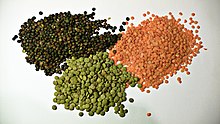Chana dal

Lentils are a staple ingredient in South Asian cuisine. Clockwise from upper right: split red lentils, common green whole lentils, and Le Puy lentils both with their outer coats visible
|
|
| Main ingredients | Lentils, peas or beans |
|---|---|
| |
|
Dal (also spelled daal; pronunciation: [d̪aːl]) is a term in the Indian subcontinent for dried, split pulses (that is, lentils, peas, and beans). The term is also used for various soups prepared from these pulses. These pulses are among the most important staple foods in SAARC countries, and form an important part of Indian, Nepalese, Pakistani, Sri Lankan and Bangladeshi cuisines.
Dals are frequently eaten with flatbreads such as rotis or chapatis or with rice, a combination referred to as dal bhat. Dals are high in protein relative to other plants.
The outer hull is usually stripped off; dal that has not been hulled is described as chilka (skin), e.g. chilka urad dal, mung dal chilka in Hindi/Urdu. The term dal is often contrasted with the term gram, used in South Asia for pulses that are whole rather than split.
The word dāl derives the Sanskrit verbal root dal- "to split".
Dal preparations are eaten with rice, as well as rotis, chapati and naan on the Indian subcontinent. In India, it is eaten with rice and with a wheat flatbread called roti. The manner in which it is cooked and presented varies by region. In South India, dal is primarily used to make the dish called sambar. It is also used to make pappu that is mixed with charu and rice.
...
Wikipedia
